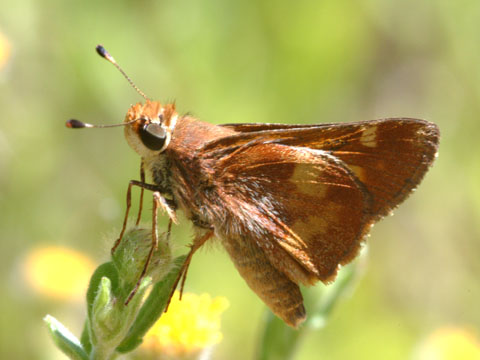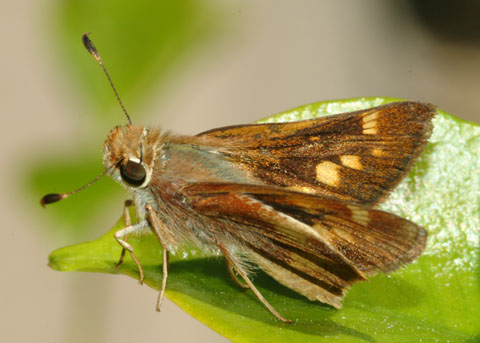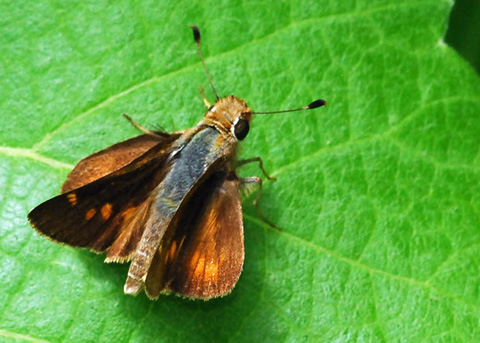 Modjeska Canyon, Orange County, CA. 7/21/05. © Peter J. Bryant. |
Umber Skipper Poanes melane Lepidoptera: Hesperiidae Back to Butterflies of Orange County, California |
 Zuma Beach, Los Angeles County, CA. 3/30/07. © Peter J. Bryant |
Irvine Regional Park, Orange, Orange County, CA. 4-13-07. © Ron Hemberger |
Irvine Regional Park, Orange, Orange County, CA. 4-13-07. © Ron Hemberger |
Irvine Regional Park, Orange, Orange County, CA. 4-13-07. © Ron Hemberger |
 Huntington Central Park, Huntington Beach, Orange County, CA. 10-30-08. © Ron Hemberger |
 Oak Canyon Nature Center, Anaheim, Orange County, CA. 6-11-10. © Ron Hemberger |
Characteristics: Dorsal wing dark brown. Dorsal forwing with orange and semihyaline (translucent) spots. Dorsal hindwing with a suffused orange transverse band. Ventral wing a rich chestnut brown. Forewing length: 14-17 mm. Similar Species: Euphyes vestris ssp. (Dun Skipper). The dorsal hindwing pattern of each is sufficiently different to enable easy identification. The Dun Skipper lacks the distinct appearing arched orange transverse band on the dorsal hindwing. Habitats, Behavior: The Umber Skipper apparently inhabits much the same area as the Woodland Skipper (Ochlodes sylvanoides). Shady washes and moist canyons are preferred in the Santa Ana Mountains and foothills. Likewise, I have found melane flying in a shady, moist habitat in an older section of Newport Beach. No doubt the Umber Skipper would also feel very much at home in the vicinity of old, overgrown flood control channels, such as those found in some areas of Fullerton. It is rarely common in any one spot. Distribution: Moist canyons in the Santa Ana Mountains, Upper Newport Bay (e. g. Big Canyon), Villa Park Dam, Aliso Canyon, and several localities in urban Orange County. Generally absent or rare in the suburbs at present. Flight Period: Our records extend from March to October; multiple brooded, but probably most common in late summer. In San Diego, the Umber Skipper flies from January to November (Heppner, 1972). Larval Foodplants: Undetermined species of grasses. Comstock and Dammers (1930) observed melane ovipositing on a wide variety of lawn grasses, and reared larvae in the lab on Bermuda Grass (Cynodon dactylon). Other Remarks: Heppner (1972) mentions that melane was present in Los Angeles County in earlier years. Although suitable habitats for the species were present in San Diego County, unknown factors prevented this skipper from penetrating south into the San Diego area until the late l930's and she early l940's. In view of this, it is interesting that melane occurred in adjacent Orange County as early as 1904 and was captured throughout the 1930' s in the lowlands, as well as in the Santa Ana Mountains, although it was still absent in San Diego County. This perhaps suggests temporary difficulties in breaching the Santa Ana Mountain "barrier". Records seem to indicate that melane became abundant in Orange County in the 1930's, preceding its establishment in San Diego County by 1936. An enterprising lepidopterist might try to discover the grass species utilized as larval foodplants (both in the suburbs and the mountain canyons). Factors limiting the distribution and habitats of the species are not known, and an advanced student might consider an investigation of the behavior and dispersive capabilities of the species. From Orsak, L. J. (1977). The Butterflies of Orange County, California. Center for Pathobiology Miscellaneous Publication #3. University of California Press, New York. 349pp. Return to Butterflies and their larval foodplants |
|
